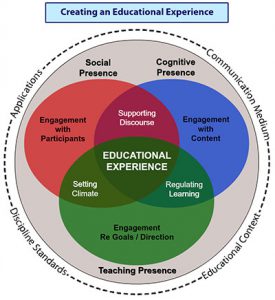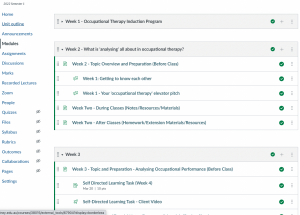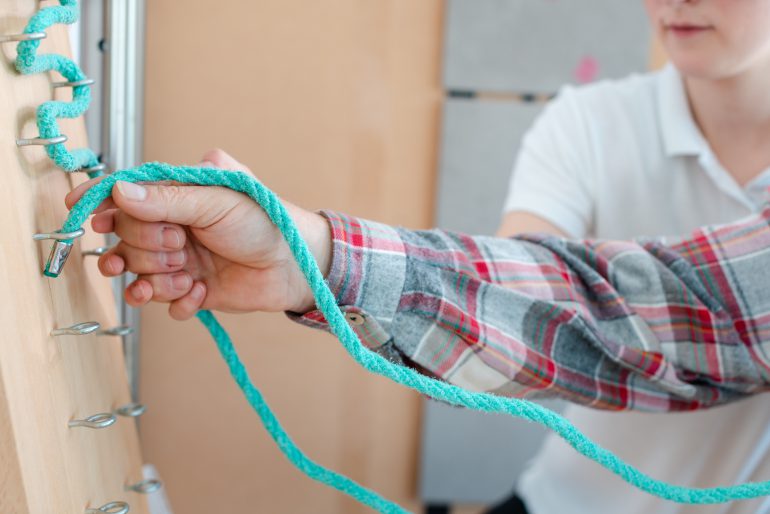This case study outlines an ongoing collaboration between Dr Joanne Hinitt, unit coordinator of OCCP1104 Analysing and Teaching Occupations, and educational designer Kria Coleman, focussed on building a flexible and accessible unit of study for first year first semester undergraduate occupational therapy (OT) students.
Our focus has been on creating a collaborative learning community and increasing engagement and active learning opportunities to ensure that students develop the foundational skills, knowledge, and approaches to learning that will underpin their ongoing studies.

Stage 1 – January 2022
Building belonging and engagement through Canvas Discussions
At the start of 2022 Joanne identified that as we emerged from remote learning, increasing interaction, belonging, and engagement were key to ensure her students started their studies well. After initial discussions, we identified increased use of Canvas as an opportunity to support students in their transition to University, to ensure learning expectations were clear, and to start building a learning community from the first week of semester. Designing the activities to ‘live’ in Canvas meant that they were ready for use in a hybrid mode, in an in-person classroom, or remotely, which proved fortuitous as Sydney soon faced storms, flooding and transport challenges. With the Community of Inquiry framework as our guide we decided to focus on Canvas Discussions primarily due to the tool’s visibility options; discussion threads to host student work can be made visible to entire cohorts or just to individual tutorial groups.
The discussions were intended to be used synchronously in the classroom but could also be completed remotely if needed. Some were individual tasks and others were designed to be completed by groups of students working together. There were several different types of activities developed, including debating an issue, researching a topic and reporting back to the class, or collaborating on a case study or problem. Each discussion was set up to be marked complete/incomplete, allowing teachers to monitor student progress. Discussions also allowed them to dip into the conversation, adding a comment to keep things on track. Past experience with discussions told us that interaction with them could easily be superficial, so these Canvas discussions were intentionally structured with explicit instructions to reduce ambiguity and make clear to students how much detail was needed in each interaction. As a result, we saw higher quality discourse in the tasks.
Stage 2 – February 2022
Building skills in self-managing learning for university

We were conscious that OCCP1104 students were simultaneously transitioning into higher education, learning about new academic expectations and discovering what their chosen discipline is all about. While students arrive at university with much anticipation, it takes time to learn about how to be successful. Coming from a variety of educational backgrounds we sometimes assume students have the self-regulation skills needed to become successful in a higher education setting (MacMahon, Carroll, Osika, & Howell, 2022), however intentional design can support students to adjust to a learning environment that requires greater learner independence.
With this in mind, we reviewed the structure of the unit’s Canvas site with the student navigational experience as a priority. Rather than organising content by type (e.g. grouping lecture resources in one place and tutorial resources in another) we structured the site by week, creating individual modules for each. There was no need to create any new content, just to reorganise that which was pre-existing. For each weekly module we mapped the topics in terms of learning goals and what students needed to do before class, clearly signposting lecture recordings, resources and related activities, including tutorial activities that generated interaction, and identifying independent learning consolidation tasks.
Joanne also used the Student Relationship Engagement System (SRES) to create weekly lecture check-ins that also served as a way of checking in on student wellbeing and content understanding, especially important as the early weeks of semester were quite disrupted. It was also useful to get regular feedback on approaches to learning that students enjoyed or found valuable. This approach to teaching and learning design mirrors an occupational therapy disciplinary worldview that is very client-centric, modelling best practice for future practitioners.
Student feedback indicated that this made the site easy to navigate and teachers noticed increased engagement with pre-work required for classes
2023 – Flipping some learning to make better use of face to face time

Rethinking content organisation to improve student engagement and learning
The flipped classroom is not a new concept, but one that needs an intentional and consistent design. Given that this is a first year, first semester unit of study it is important establish expectations about the approaches to learning that will be helpful to students. A priority for this year was to help students appreciate the importance and value of work done outside of attending class. This pre and post class work was tightly and openly linked to the content covered each week, and added value in terms of developing skills for upcoming assessments rather than just being what students may perceive as ‘busy work’ (Motz, Quick, Wernert, & Miles , 2021, p. 79).
Reviewing the syllabus helped to identify content that’s more static and unchanging from one semester to the next, other more dynamic content that needs a fresh delivery each iteration, and also content that is best presented in a more interactive and exploratory way. In preparation for Semester 1 2023 we used a Miro Brainwriting page to review the syllabus week by week, identifying and linking themes, learning outcomes, pre-work, seminar content, tutorial content, formative and summative assessment opportunities and independent study expectations.
This content re-scoping has resulted in pre-recorded short (10 minute) videos covering content that remains consistent from one semester to the next. These videos have embedded active learning tasks using Echo 360 polling tools. Content that has more currency is presented in live lectures and also saved to a Canvas page along with tasks which challenge students to review and critically engage with the content. Readings and other resources that support tutorials are released in time for students to use in the timetabled, face-to-face classes. Independent consolidation tasks have also been developed as formative activities linked to assessments; not simply ‘busy work’ but an opportunity for students to develop knowledge and skills that will improve assessment outcomes.
The Canvas modules utilise the time release function to publish content as it is needed. This allows time to fine-tune and respond to student feedback as the semester unfolds, monitoring pre-work completion, and adjust lectures and tutorials if needed.
The changes made to Canvas are paying off. Student survey feedback includes the following comments:
Layout is easy to navigate. All relevant information is in the one place.
The quick link page makes it easy to access the weekly work. It is clear and very organised so I can be sure what is expected and due each week
I like how each week is broken down into pre-work, during class and after class. I also like the weekly end of week checklists as it puts everything that we need to do.
Collaborating to improve the student experience
Our collaboration has emphasised that value of utilising colleagues as a sounding board when developing approaches to teaching, and when experimenting with the use of Canvas features. Working together to review, collect feedback, and make adjustments as the semester has unfolded has meant that the time already invested in developing the unit of study will be capitalised on with further improvements. Re-approaching the Canvas site design with a focus on improving student navigation has also had the impact of improving teacher navigation; reducing cognitive load when working with resources now all located together, and subsequently allowing for more adaptability in the classroom and mental space for teachers.
References
Tell me more!
- Attend a Canvas workshop to find out more about how to make the most of the features available to support your students’ learning
- Find out how to utilise the Student Relationship Engagement System (SRES) in a way that makes sense for you to support your students’ learning and welfare
- Read about other colleagues’ approaches to re-thinking their Canvas site design to increase student engagement





